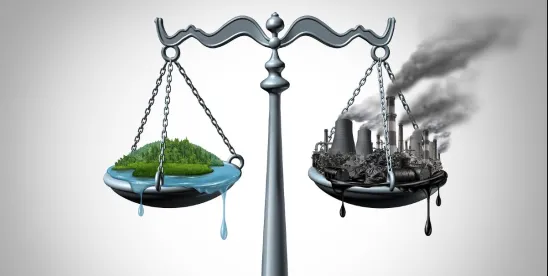Decarbonising Natural Gas and LNG
Natural gas and liquefied natural gas (“LNG”) have long been hailed as one of the winners of the current energy transition when compared to other fossil fuels. Carbon dioxide (“CO2”) emissions from the combustion of natural gas are approximately half that of coal and the combustion of natural gas creates far fewer other pollutants, such as particulates, compared to other hydrocarbons and coal.[1] The expectation was that gas would replace coal as part of the energy transition, while the scale and technology underpinning cleaner forms of energy production grow and develop.
However, natural gas and LNG are increasingly under the spotlight with questions raised as to both the suitability of natural gas and LNG as the “transition fuel” of choice, and the long-term role of gas in the global energy mix. Notwithstanding that natural gas is less harmful to the environment than the traditional alternatives, it is a fossil fuel and its continued use contributes to climate change. Therefore, some argue, that we should focus exclusively on cleaner forms of energy.[2]
As a response, market players in the natural gas and LNG sector are increasingly considering and implementing measures to reduce the environmental impact associated with their products. Such measures include limiting the amount of methane (the main constituent of natural gas) and CO2 released when extracting and liquefying natural gas, carbon capture and storage (“CCS”) and carbon offsetting. This article looks at those mitigation efforts.
Role of Gas and LNG and Projected Global Demand
The outlook for natural gas is much more resilient than other fossil fuels. In the short term, the International Energy Agency estimates that natural gas demand will increase by an average 1.7% per year between 2022 and 2024.[3] In the medium term, by one estimate natural gas will be the only fossil fuel for which demand will continue to increase beyond 2030.[4] From 2035 to 2050 natural gas demand is expected to remain largely stable, only decreasing by 0.4% over the period.
LNG is expected to remain in particular demand, with much of the greatest demand coming from Asia where there are low levels of domestic natural gas production and limited gas pipeline infrastructure, meaning that imported LNG is the main source of supply. Demand for LNG is expected to increase until 2040 and beyond, with Shell estimating that a significant supply-demand gap will emerge by 2030.[5] Natural gas and LNG are therefore likely to continue to have a significant role to play in the global energy mix throughout the energy transition.
Coal-to-Gas Switching
The development of a global LNG market has facilitated economies with high energy needs but without sufficient domestic natural gas production, such as China, Japan and Korea, to switch from highly polluting coal-fuelled power generation to cleaner natural gas-fuelled power generation. One of the key perceived failures of the recent COP26 Summit and the Glasgow Climate Pact was that the reference to a “phase-out” of unabated coal power was replaced with a reference to a “phasedown” near the end of the summit. Indeed, after coal use fell globally in both 2019 and 2020, global coal use grew in 2021 by an estimated 9% to be the highest annual consumption on record.[6] One of the reasons cited for the increase use of coal in Europe in particular was the steep rise in natural gas prices (over 800% between January and December 2021, with LNG cargoes delivered ex-ship North West Europe reaching record prices of $41.946/MMBtu in December). [7] [8] Increased reliance on coal is a big concern if climate change targets are to be met, and serves to highlight the importance of continuing to include a material role for natural gas and LNG as part of the energy transition.
Where do greenhouse gas emissions arise in the LNG value chain?
The LNG value-chain can be split into the three elements:
-
upstream – natural gas extraction and production, transportation and liquefaction;
-
midstream – LNG transportation; and
-
downstream – LNG regasification and combustion (i.e use of the regasified LNG as a fuel).
The Upstream and Midstream
Approximately 25% of CO2-equivalent (“CO2e”) emissions arise in the upstream and midstream sections of the LNG value chain.[9] In the upstream, methane emissions arise through intentional venting (usually of associated gas in upstream operations focused on oil production and therefore not particularly relevant in the LNG value chain), intentional release in emergency scenarios and as fugitive emissions, such as through accidental leakage in infrastructure. There are also significant CO2 emissions associated with upstream gas production and in the liquefaction process, for example in flaring of gas (again more relevant to upstream operations focused on oil production) and through the powering of drilling and operational machinery, as well as in powering the energy-intensive liquefaction process. Natural gas production and liquefaction infrastructure is often powered by the burning of natural gas or other hydrocarbons, resulting in emissions of between 10 – 25% of overall GHG emissions for the production of natural gas and transportation to the liquefaction plant, with the liquefaction process typically accounting for between 6 – 10% of overall GHG emissions.[10]
The midstream, being the transportation of natural gas once liquefied (i.e. LNG), is also responsible for both methane and CO2 emissions. LNG ships typically burn marine fuel oil or natural gas (from boil-off of the LNG being transported) producing CO2 emissions on combustion. Methane leakage or methane slip may also occur, particularly with older LNG ships, with non-combusted methane being released into the atmosphere.
The Downstream
The downstream element is responsible for the most GHG and particulate emissions in the LNG value chain, with a standard cargo of 70,000 metric tonnes (“MT”) of LNG, once regasified and combusted, resulting in 190,000 MT of CO2e.[11] These emissions arise when LNG is regasified and subsequently combusted (for example in power plants). The regasification process is typically responsible for between 1-3% of overall emissions, a tiny proportion of emissions as a whole.[12] The end combustion of natural gas, however, is responsible for emissions in excess of 60% of the overall LNG value chain. Whilst this highlights the intensity of emissions associated with the use of natural gas in power generation, as noted above, these remain comparatively low when compared to other baseload power alternatives such as coal, which produces twice as many GHG emissions as natural gas.
What is Green Gas / LNG?
There are several ways in which natural gas and LNG can be produced and used in a way that limits its detrimental effect on the environment such that it is characterised by some as “Green LNG”. These include:
-
reducing the greenhouse emissions associated with the upstream production of natural gas;
-
utilising CCS in respect of CO2 emissions associated with the upstream production of natural gas, the liquefaction process used to produce LNG and the regasification process;
-
offsetting the carbon emissions associated with the production, transportation and use of LNG;
-
the use of alternative sources of natural gas, such as so-called “bio-LNG”; and
-
LNG blended with hydrogen.
Electrification of existing infrastructure
The production and subsequent liquefaction of natural gas is an energy intensive process. The electrification of oil and gas platforms using power from renewable sources (such as offshore wind farms) has the potential to abate significant emissions associated with oil and gas production. The UK Oil and Gas Authority concluded that electrification had the potential to reduce 20% of 2020 operational CO2e emissions, rising to 40% by 2030.[13] Further electrification of natural gas production and liquefaction infrastructure has the potential to significantly reduce GHG emissions in the sector – with the added benefit of preserving natural gas for liquefaction, rather than being used for power-generation in the production/liquefaction process.
The role of carbon capture and storage
One way in which LNG producers are seeking to minimise GHG emissions associated with their upstream operations is by capturing and storing CO2 emissions. CCS involves the capture of CO2 emissions before they are emitted into the atmosphere, with the CO2 then injected into geological formations underground.
The $28.75bn North Field Expansion Project in Qatar will include a reported $200m of expenditure on emissions reduction technology, minimising emissions from upstream operations through the use of renewable energy sources to power upstream infrastructure. The project will also utilise CCS to minimise CO2 emissions that cannot be avoided in the natural gas production and liquefaction process. In the US, LNG exporters are planning to use CCS to minimise emissions and perhaps as a means of separating their product from competitors, with a number of US LNG exporters proposing to deploy CCS technology to minimise emissions associated with the energy-intensive liquefaction process. CCS technology can also be used to capture emissions associated with the combustion of natural gas, which, as discussed above, is where the majority of CO2 emissions arise. Whilst there are a number of planned natural gas power stations featuring CCS or CCS upgrades to existing power stations, there are not currently any utility-scale gas power projects integrating CCS technology in full commercial operation. However, CCS has not been an unmitigated success, with the difficulties in successfully implementing CCS at the Gorgon LNG project demonstrating that CCS may not be a “silver bullet” for minimising CO2 emissions in the LNG value chain.
Carbon Offsetting
What is offsetting?
Perhaps the biggest development in the Green LNG space is the emergence of integrated carbon offsetting in sales of LNG cargos. This involves offsetting the CO2 emissions associated with an LNG cargo through the purchase of verified/voluntary emissions reduction (“VER”) certificates, with each certificate equivalent to the offsetting of one metric tonne of CO2e. VER certificates are distinct from compliance derived carbon credits, such as the EU Emissions Trading Scheme, the UK Emissions Trading Scheme and the Regional Greenhouse Gas Initiative.
The LNG-offsetting market is bespoke and the size of the offset can be tailored to cover the preferred “scope” of the party’s emissions. These are:
-
Scope 1 – direct emissions arising from the reporting party’s operations;
-
Scope 2 – indirect emissions arising from the reporting party’s operations; and
-
Scope 3 – all other indirect emissions in the reporting company’s value chain that are not within Scope 2.
The table below sets out the various scope of carbon dioxide emission in LNG value chain:
|
Party |
Upstream (Natural |
Midstream |
Downstream |
|
LNG |
Scope 1 and 2 |
Scope 3 |
Scope 3 |
|
LNG |
Scope 3 |
Scope 1 and 2 |
Scope 3 |
|
End |
Scope 3 |
Scope 3 |
Scope 1 and 2 |
Participants in the LNG value-chain have entered into a range of “scoped” offsets, primarily in the spot market, with some transactions just covering the buyer’s Scope 1 and 2 emissions, and with others covering Scope 1, 2 and 3 emissions. There are signs that this may expand beyond the spot market into long-term LNG sale and purchase agreements, with Shell signing an LNG SPA with Petrochina for the supply of offset life-cycle CO2e emissions generated across the value chain (i.e. for Petrochina’s Scope 1, 2 and 3 emissions). Recently US LNG player, Tellurian, announced that it has begun a partnership with the US National Forest Foundation (NFF) on a five-year, $25 million plan for reforestation and other projects across the US. One of the first projects would be to re-plant 300,000 trees in the Kisatchie National Forest.
Is offsetting enough?
Criticisms of offsetting generally apply equally to the use of offsetting in the LNG sector. Critics often argue that offsetting enables “business as usual”, when more effort should be focused on eliminating the use of fossil fuels, such as natural gas, entirely. Others criticise offsetting as an ineffective means of mitigating the environmental effects of continued use of fossil fuels with any benefits not becoming apparent for a number of years (in which case it may be too late) or instead noting the practical reality that offsetting solutions – such as relying on afforestation to store carbon in an ever-hotter and more forest fire-prone world – may not be an effective means of sequestering CO2 in the long-term. These also accompany concerns about the “carbon accounting” on which parties calculate the emissions to be offset and the failure to address all the consequences of holistic life-cycle GHG emissions, including methane, rather than just CO2.
A variety of offsetting options are available, some of which may do better at addressing these criticisms than others. The table below sets out an (inexhaustive) list of the various options available.
| Type of Offset | Examples |
| Removal Credits | Direct air capture, afforestation |
| Avoidance Credits | Forest protection |
| Abatement Credits | Renewable energy generation |
Whilst the debut of “carbon neutral hydrocarbons” has been headline grabbing, LNG cargoes with offset emissions remain a small proportion of the overall LNG market with only approximately 30 carbon-offset LNG cargoes agreed since 2019.[14] Whether buyers are willing to accept additional costs attached to cargoes in a high-price environment also remains to be seen. The cost of offsetting lifecycle emissions for an average cargo reached approximately $1.8m in September 2021, a significant incremental cost in the context of a high-price environment.
To date, carbon offsetting in the LNG sector has largely been ad hoc, with inconsistent approaches taken across transactions. The International Group of Liquefied Natural Gas Importers (“GIIGNL”) launched a comprehensive framework in November 2021 with the aim of standardising the approach taken across “carbon neutral” LNG transactions. The aim of GIIGNL’s framework is to encourage emission avoidance and reduction and to create a transparent process to declare carbon neutral cargoes. The establishment of the framework demonstrates the increasing importance of “carbon neutral” LNG and the framework will, hopefully, encourage best practices in the LNG sector with respect to this new product.
Bio-LNG
Methane can also be obtained through industrial processes, as well as through extraction from the Earth (as natural gas). Organic matter such as food waste can be made to decompose in an oxygen-starved environment in a process called anaerobic digestion. “Biogas” is produced in this process which can be further “upgraded” into “Biomethane”, often referred to as “renewable natural gas”. Similarly, the emissions from landfill can be captured and upgraded into biomethane. This bio-methane can then be used in the same way as natural gas, or liquefied into so-called “Bio-LNG”.
Whilst the combustion of this biomethane still results in GHG emissions, this process has the benefit of avoiding methane emissions that would have occurred naturally from the decay of the relevant organic material, with those methane emissions instead being released as less potent CO2. It is also “renewable” in the sense that it is not being produced from a finite resource and is a less-energy intensive to produce than natural gas LNG.
This Bio-LNG can then be blended with ordinary LNG. The use of blended Bio-LNG is currently used in small-scale applications, for example in powering haulage vehicles, which has the benefit of abating some of the emissions that are produced from traditional fuels such as diesel and also producing less particulate pollution.
Biomethane production levels are currently relatively low, with approximately 3.5 million tonnes of oil equivalent (“Mtoe”) produced in 2018, a fraction of potential production levels and demand for natural gas (which biomethane could in part replace).[15] By contrast, 3,262Mtoe of natural gas was produced in 2018.[16] Whilst biomethane and bio-LNG may have a small role to play in the LNG value chain either through blending or replacing natural gas and LNG in certain applications, the difficulties and cost of producing biomethane at scale mean that it is unlikely to pose a significant challenger to natural gas and LNG in the short term.
Hydrogen blending
Similar to the use-case for bio-methane, hydrogen can be blended with natural gas in order to reduce the emissions generated when the blended fuel combusts. In the UK, Cadent Gas has completed a successful trial project “HyDeploy” which investigated blending hydrogen into existing gas networks at a rate of up to 20% hydrogen.[17] At the utility scale, JERA has announced a feasibility study to investigate displacing 30% of the LNG that is regasified and combusted at a thermal plant in Japan with hydrogen and ammonia.[18] In this use case, hydrogen would be blended with regasified LNG at the receiving terminal such that only emissions produced in the combustion of the fuel are abated and not those in the production and transportation of LNG are abated – although of course the combustion of regasified LNG is the most emissions-intensive aspect of the LNG value chain, meaning that it has the potential to have the greatest impact on emissions.
Assuming that the hydrogen or ammonia used in any blending is “green” or “blue” hydrogen, which is associated with lower or zero direct CO2 emissions, this blending is intended to reduce the carbon-intensity of combusting natural gas and (in the case of hydrogen), reduced particulate pollution.
The implications of Green LNG
The steps discussed in this article to make LNG ‘greener’ can result in direct environmental benefits (by reducing, mitigating or abating GHG emissions) and economic benefits (by avoiding wasted natural gas and preserving it for sale). Whether LNG sellers can sell Green LNG for a higher price (including a profit element) because of its improved environmental credentials remains to be seen. The development of the GIIGNL’s framework will help to introduce some further structure to the market, but without firm regulation there will be no market price differential between regular LNG and Green LNG, such that it may be difficult to justify the increased costs associated with the development of Green LNG projects and Green LNG cargoes in contrast to those without mitigated, offset or abated emissions, particularly when LNG prices are high. In the absence of such regulation it may also be more difficult to sanction Green LNG projects or obtain financing for upgrades to existing LNG infrastructure. Nonetheless, there are clearly “push factors” that may, in future, make the roll-out of Green LNG necessary, particularly for new LNG projects.
There has already been a significant increase in scrutiny of the oil and gas sector as a whole in recent years, resulting in a tightening in liquidity for financing hydrocarbon projects. LNG projects are not immune to this pressure, with Friends of the Earth’s recent attempt to block UKEF’s financing of Mozambique LNG likely an early example of pressure that NGOs may exert to try to prevent the development of further LNG infrastructure on environmental grounds. Lenders to new LNG projects are likely to carry out enhanced due diligence on the environmental impacts of LNG projects in order to mitigate the risks arising from similar potential claims, with increased focus on compliance with the Equator Principles and other ESG standards. The adoption of mitigation and offsetting steps and technology such as CCS may become of critical importance in order to get new projects off the ground – and in future, all LNG may need to be Green LNG.
Footnotes
[1] International Energy Agency, ‘The Role of Gas in Today’s Energy Transitions’, July 2019, https://www.iea.org/reports/the-role-of-gas-in-todays-energy-transitions
[2] Discussing the feasibility and practicality of such proposals is outside the scope of this article.
[3] International Energy Agency, ‘Gas Market Report Q3-2021’, July 2021, https://www.iea.org/reports/gas-market-report-q3-2021
[4] McKinsey, ‘Global gas outlook to 2050’, 26 February 2021, https://www.mckinsey.com/industries/oil-and-gas/our-insights/global-gas-outlook-to-2050
[5] Shell, ‘LNG Outlook 2021’, https://www.shell.com/promos/energy-and-innovation/download-the-shell-lng-outlook-2021/_jcr_content.stream/1614823770264/2b5b3fdaa9feba85dadc9b3408c200f26eadf85f/lng-outlook-2021-final-pack-updated.pdf
[6] International Energy Agency, ‘Coal power’s sharp rebound is taking it to a new record in 2021, threatening net zero goals’, 17 December 2021, https://www.iea.org/news/coal-power-s-sharp-rebound-is-taking-it-to-a-new-record-in-2021-threatening-net-zero-goals
[7] Tom Wilson and Neil Hume, Financial Times, ‘European gas prices shoot to new high as energy crunch worsens’, 21 December 2021, https://www.ft.com/content/a0bc7996-ab5d-465b-aab4-90472e088af7
[8] S&P Platts, ‘Northwest Europe LNG reaches record high $41.946/MMBtu on strong demand’, 14 December 2021, https://www.spglobal.com/platts/en/market-insights/latest-news/lng/121421-northwest-europe-lng-reaches-record-high-41946mmbtu-on-strong-demand
[9] Erin Blanton and Samer Mosis, “The Carbon-Neutral LNG Market: Creating a Framework for Real Emissions Reductions”, https://www.energypolicy.columbia.edu/research/commentary/carbon-neutral-lng-market-creating-framework-real-emissions-reductions
[10] International Energy Agency, ‘Gas Market Report Q3-2021’, July 2021, https://www.iea.org/reports/gas-market-report-q3-2021
[11] Ibid.
[12] Ibid.
[13] UK Oil and Gas Authority, “Platform Electrification”, https://www.ogauthority.co.uk/the-move-to-net-zero/platform-electrification/
[14] Camilla Hodgson, Financial Times, “Rise of the ‘carbon neutral’ hydrocarbons”, 12 October 2021, https://www.ft.com/content/d6da97a7-17ec-45d1-9f90-a9cbbdd15f44
[15] International Energy Association, ‘Outlook for biogas and biomethane’, March 2020,https://iea.blob.core.windows.net/assets/03aeb10c-c38c-4d10-bcec de92e9ab815f/Outlook_for_biogas_and_biomethane.pdf
[16] International Energy Association, ‘Key world energy statistics 2020, August 2020, https://www.iea.org/reports/key-world-energy-statistics-2020
[17] Cadent Gas, ‘First UK trial of hydrogen blended gas hailed a success’, 8 September 2021 https://cadentgas.com/news-media/news/september-2021/hydrogen-blended-gas-trial-hailed-a-success
[18] JERA, ‘JERA starts hydrogen utilization demonstration project at an LNG thermal power plant in Japan’, 26 August 2021, https://www.jera.co.jp/english/information/20210826_748





 />i
/>i

